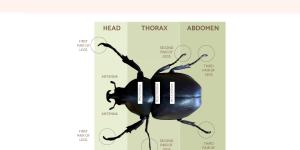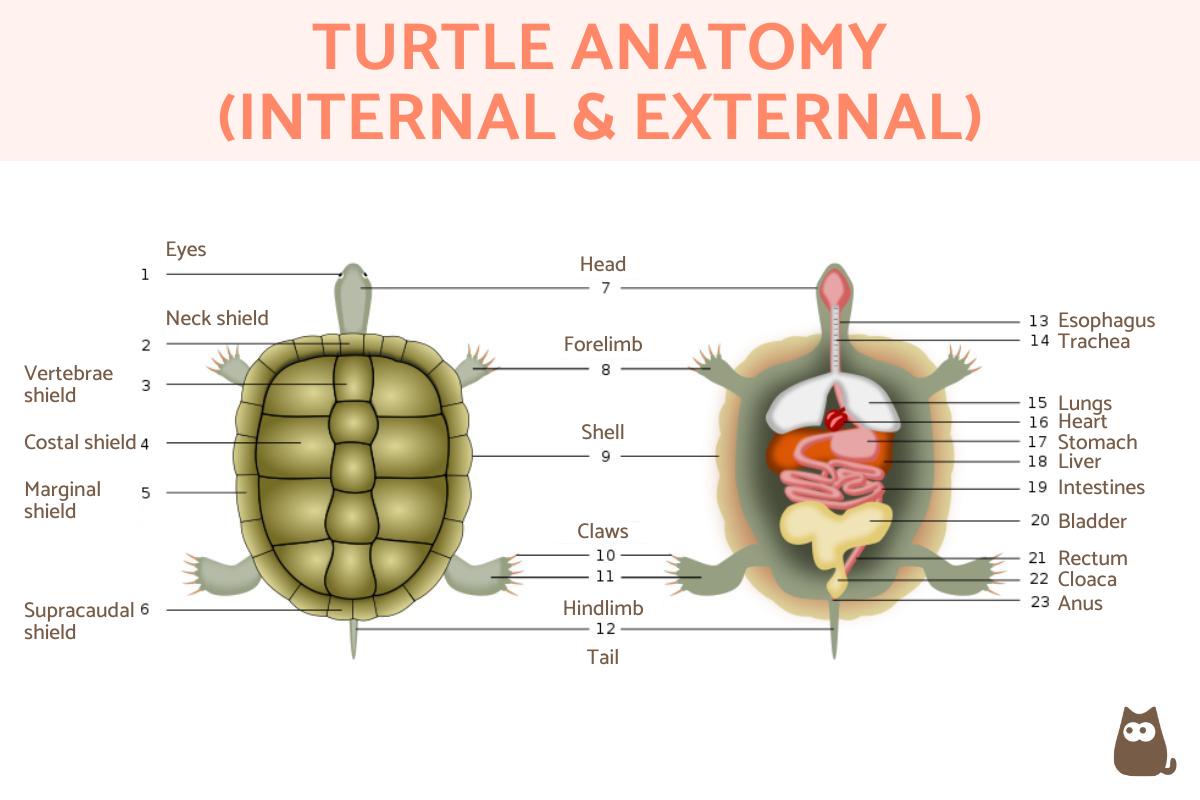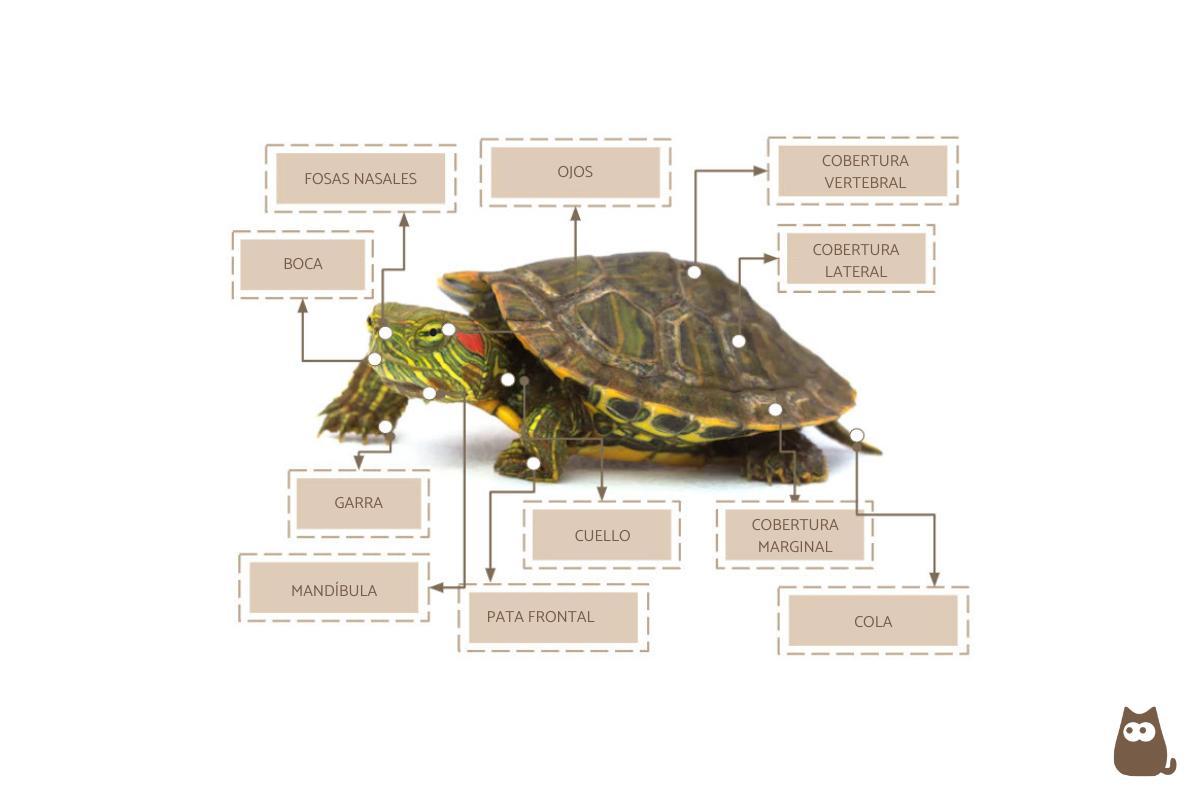Parts of a Turtle - Turtle Anatomy

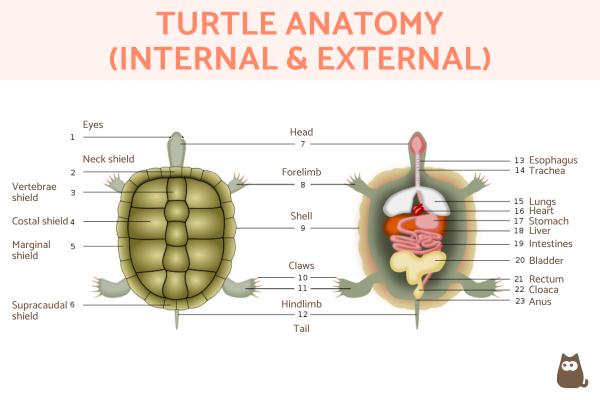
The anatomy of a turtle is one of the most unique in the animal kingdom. This is largely due to their shell, a very hard carapace which is part of their skeletal structure. This shell is used for protection, but it provides the turtle with unique abilities and behaviors. Although all turtles have certain body parts which are the same, different turtle species have certain anatomical variances. All turtle species are divided into two suborders of Pleurodira and Cryptodira, grouped this way largely due to anatomical differences. Turtles also have different body parts according to whether they are aquatic or terrestrial animals.
At AnimalWised, we discover the different parts of a turtle by looking at turtle anatomy. We discover not only what the body parts of turtles are, but also how they are adapted for their needs.
Aquatic and terrestrial turtle anatomy
The anatomy of sea turtles and land turtles have certain important differences. This is due to their various adaptations which allow them to inhabit their specific ecosystems. Although being types of aquatic or terrestrial turtles are important distinctions, they do not determine the two main suborders of turtle. These are actually anatomical differences related to how they move their heads:
- Pleurodira (side-necked turtles): used to refer to those turtles that move their heads laterally (to the side). This is thanks to the fact their vertebrae can flex laterally, meaning they are not able to retract their heads back and put them in the shell.
- Cryptodira (hidden-necked turtles): vertebrae are arranged to allow them to flex their necks vertically, meaning they can retract their heads into their shells, a trait commonly seen in various species.
The anatomical differences which have resulted in these two suborders are very important, but they are not easy to determine just by looking at the animal. These differences are mainly internal and not directly related to whether they are types of aquatic turtle or types of land turtle.
We can say that side-necked turtles are types of freshwater turtle, although there are also freshwater turtles in the suborder Cryptodira. They mainly live in parts of Australia, Africa and South America. Hidden-necked turtles include the vast majority of land turtles, sea turtles, soft-shelled turtles and snapping turtles. Generally speaking, hidden-necked turtles have a much greater anatomical diversity.
Regardless of their suborder, there are certain very important distinctions between terrestrial and sea turtles:
- The extremities of sea turtles have been modified into flippers which allows them to swim better. Land turtles have legs to walk and many species use them to dig in the ground. In the diagram above, you can see land turtles because of the presence of claws.
- Sea turtles usually have soft and aerodynamic shells. The shells of land turtles tend to be heavier and very hard, making them much less adapted to facilitate swimming.
- The eyes of sea turtles are anatomically adapted to see underwater, even allowing some to see well in murky waters. Tortoises lack these adaptations, which are related to the way they focus images.
- Sea and freshwater turtle species must always surface periodically to breathe air through their lungs. They have developed the ability to stay underwater for variable lengths depending on the species, but many can also breathe through their cloaca[1]. This organ is able to perform limited gas exchange while underwater, something about which you can learn more with our article on how do turtles breathe?
Differences in anatomy exist within the same species of turtle. Learn more with our article on how to tell if a turtle is male or female.
External body parts of a turtle
Now we know a little about how the general turtle anatomy can help us distinguish between species, we can look in greater detail at the external body parts of a turtle (shown in diagram below):
Head
The turtle has a head that contains a skull, as is common in vertebrate animals. Their skull differs because they do not have temporal openings. These are openings which would be otherwise used to attached certain muscles.
The mouth of the turtles varies. In some cases, it is more beak-shaped and in others it is more rounded. A common aspect is that no species of turtle has teeth. Some sea turtles have keratin structures that help in feeding. Despite a lack of teeth, some turtles have incredible strength in their jaws which can do serious damage to potential prey.
Neck
Depending on the species, they can have longer or shorter necks. In some species, this part of a turtle's anatomy is very long and flexible. As detailed above, some can only move their necks laterally and others can put it in the shell, depending on the suborder to which they belong.
Shell
The shell of the turtles is the most peculiar anatomical feature of this reptile. Contrary to what is often believed, turtles do not have an exoskeleton. The shell is part of a modified ribcage which is also attached to part of the vertebral column. They have the hard shell on top and another protective ventral shell at the bottom known as the plastron. This is flatter than the curved top shell. The parts of the turtle shell consist of about 50 to 60 bones.
Extremities
Among the parts of the turtle we also find the limbs, specifically their four legs. Generally speaking, they have four fingers, but there are differences depending on the type of habitat in which they live. The terrestrial tortoises have short fingers, but stronger legs. This is so they can walk, dig and climb, even if they may do so at a slower pace.
The types of freshwater turtle have more flexible legs. This is because they are needed not only for swimming, but also for walking on sometimes muddy bottoms. As we have already mentioned, sea turtles have legs modified into fins to better facilitate swimming in the oceans.
Senses
Regarding a turtle's sensory anatomy, we can look at the eyes. These have certain differences to capture light, depending on whether they live in water or on land. They have nostrils through which air enters to breathe. As for hearing, they do not have external ears, but they are not deaf since they have an internal auditory system.
Tail
Turtles have tails. It is usually short, although there are variations depending on the species. Some land tortoises have a somewhat longer tail to help them balance while climbing. Usually the males of marine species also have it a bit longer to aid them during reproduction. This is because they can attach it with the female for better purchase when they copulate.
Check out our related article to learn more about the reproduction of turtle and tortoises.
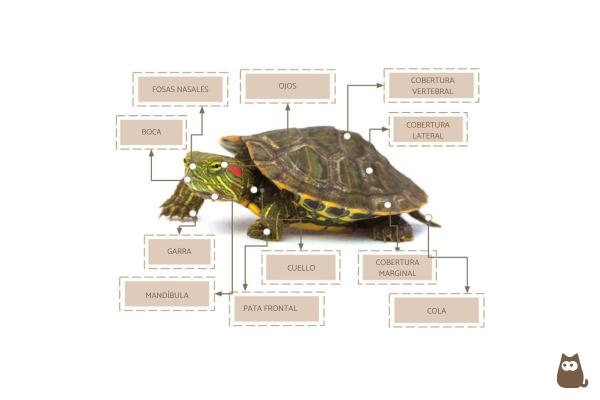
Internal body parts of the turtle
Among the internal parts of the turtle (shown in main diagram of this article) we can find the following:
- All types of turtles have eight vertebrae.
- Within the rib cage are the pectoral and pelvic girdles, parts of the skeleton that have adapted to secure fins or limbs to the skeletal structure[2].
- The limb bones are modified so they can be adapted for the shell.
- The auditory system is made up of the middle and inner ear. They have an eardrum, meaning that turtles are able to hear.
- They possess lungs which have a muscle sling attached to the shell to better facilitate respiration.
- They have a large liver.
- The heart has three chambers, as well as blood vessels to transport blood to the tissues of the body.
- The digestive system includes the stomach, intestines, gallbladder, pancreas and spleen. Discover more about turtle diet with our article on why is my turtle not eating?
- They have an excretory system which is related to the kidneys, bladder, colon and anus.

If you want to read similar articles to Parts of a Turtle - Turtle Anatomy, we recommend you visit our Facts about the animal kingdom category.
1. Gordos, M. A., Limpus, C. J., & Franklin, C. E. (2006). Response of heart rate and cloacal ventilation in the bimodally respiring freshwater turtle, Rheodytes leukops, to experimental changes in aquatic PO2. Journal of comparative physiology. B, Biochemical, systemic, and environmental physiology, 176(1), 65–73. https://doi.org/10.1007/s00360-005-0033-z
2. Nagashima, H., Hirasawa, T., Sugahara, F., Takechi, M., Usuda, R., Sato, N., & Kuratani, S. (2013). Origin of the unique morphology of the shoulder girdle in turtles. Journal of anatomy, 223(6), 547–556. https://doi.org/10.1111/joa.12116
- Hickman, C., Roberts, L., & Parson A. (2000). Comprehensive principles of zoology. McGraw Hill Inter-American: Spain.
- Pecor, K. (2003). Testudines. Animal Diversity Web. Retrieved from: https://animaldiversity.org/accounts/Testudines/
- Wyneken, J. (2004). The anatomy of sea turtles. Retrieved from: http://www.anato.cl/00010links/textos/ANATO%20TORTUGAS.pdf




